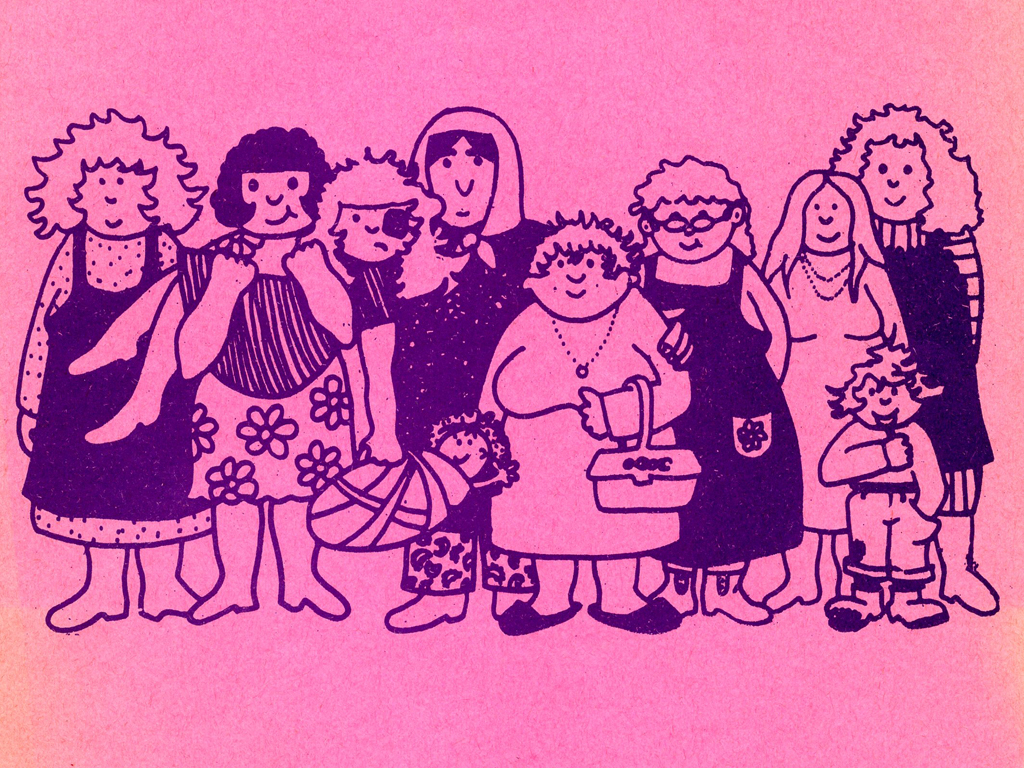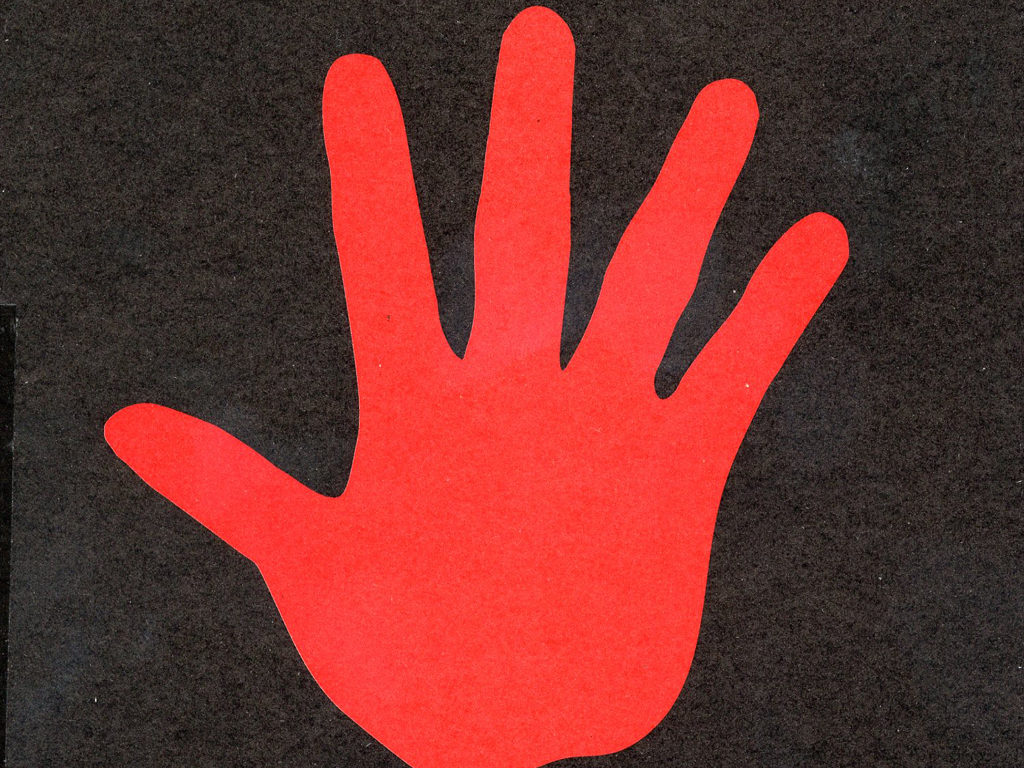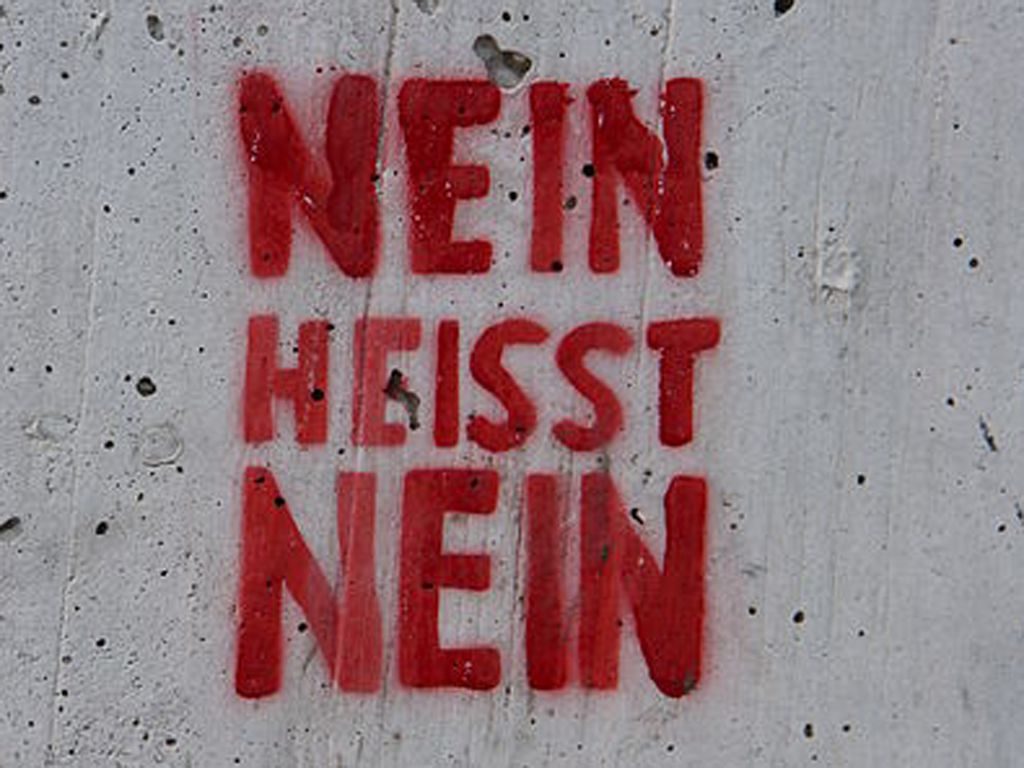Beginning in the mid-70s, the women’s movement made the dramatic extent of violence by men against their own wives and children public and launched the first women’s refuges, which are based on a foreign model.
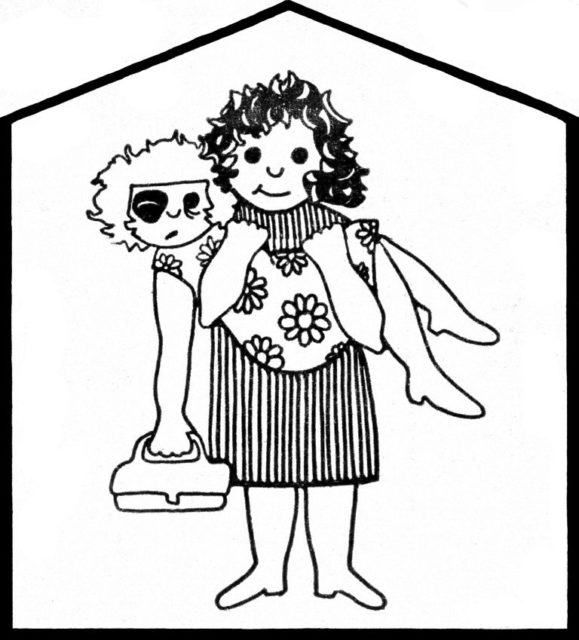
In November 1976, the first independent women’s refuge in Germany opened in Berlin, soon to be followed by others. Counter to the propaganda of the family as a ‘safe place’ – and although male violence within marriage and relationships continued to be denied despite overcrowded women’s shelters – the women’s movement was increasingly able to create public awareness for the everyday violence to which many women and children are subjected. Women’s refuges quickly became more professional, and a nationwide network of refuges and other aid services emerged. Today there are approximately 350 women’s refuges in Germany. However, their funding is still not the obligation of the state. Thousands of women and children seeking sanctuary have to be turned away each year.
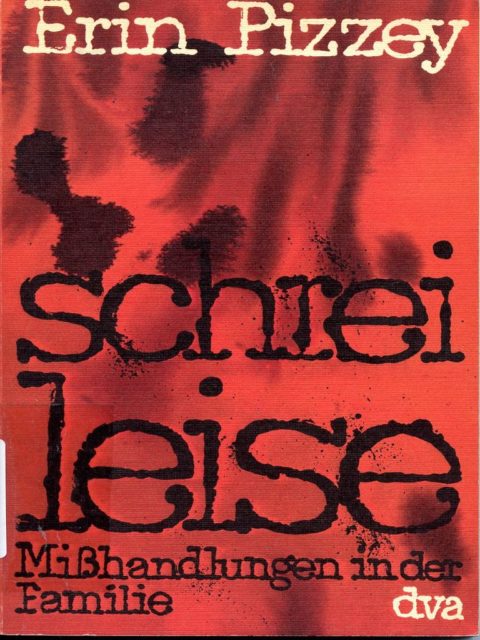
1971: First Women’s Refuge in London
The first women’s refuge in the world is set up by the social worker Erin Pizzey in London. With increasing frequency, Pizzey – who had initially worked in a community counselling centre – encountered battered wifes who despite years of abuse were forced to stay with their abuser because of the absence of alternative accommodation. Pizzey at first opens an unofficial women’s refuge in Chiswick and later a larger refuge: the Women’s Aid Centre. Since Pizzey does not turn any women away, the women’s refuge is permanently overcrowded with more than 150 women and their children. Other women’s groups follow Pizzey’s lead. In 1976, there will be more than 90 women’s refuges in England.
1974: Scream Quietly by Erin Pizzey

Erin Pizzey’s Schrei leise1 (Scream Quietly or the Neighbours Will Hear, 1971) about her experiences at the women’s refuge is published in Germany.2 The activist is invited to give international readings of the book, published in England three years earlier, and thus contributes to the establishment of women’s refuges also in other countries. More women’s refuges open worldwide, for example in Scotland, the Netherlands, the USA, and Australia.3
27 February 1976: Public Attention Increases
The weekly newspaper Zeit reports on the subject of rape and violence within marriage under the headline Die Frauen als Opfer der Männer. The newspaper refers to the book Against Our Will by the American feminist Susan Brownmiller, which had recently been published in the USA (German: Gegen unseren Willen, 1977). The topic of (sexual) violence against women, which is increasingly brought to the public’s attention by the women’s movement, receives such widespread positive response that it is now increasingly picked up by the media.
4-8 March 1976: International Tribunal – Violence Against Women
![Internationales Frauentribunal Brüssel 4.-8. März 1976. Frauengruppen <Bremen> [Hrsg.] - Bremen : Selbstverlag (FMT-Signatur: SE.01.038) Internationales Frauentribunal Brüssel 4.-8. März 1976. Frauengruppen [Hrsg.] - Bremen : Selbstverlag (FMT-shelfmark: SE.01.038)](http://frauenmediaturm.de/wp-content/uploads/2018/07/Internationales_Frauentribunal_Bruessel_1976-480x640.jpg)
14 April 1976: Rape within Marriage
The Stern publishes the results of a survey it commissioned. Title: Mein Mann hat mich vergewaltigt. Result: “In one in five marriages, the woman is forced to have sex.” That corresponds to approximately 2.5 million women in the FRG. Similarly, every one in five women is also of the opinion that a wife must be “sexually available for her husband whenever he feels like it.”5
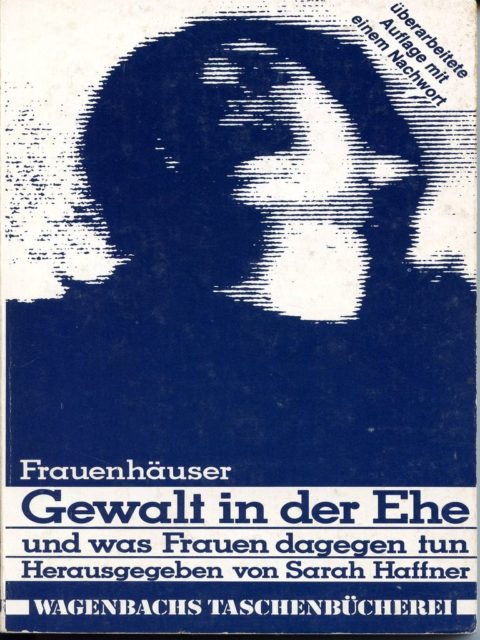
26 April 1976: Documentary About Domestic Violence
The ARD broadcasts the documentary Schreien nützt nichts – Brutalität in der Ehe by Sarah Haffner. The author unearthed approximately 400 cases of ‘domestic violence’ during her research. “We heard stories that, in their cruelty, surpass anything we could have imagined ourselves, without any kind of support or redress being provided”, Haffner reports. Haffner will turn her research into a book entitled Gewalt in der Ehe und was Frauen dagegen tun: Frauenhäuser.6 Sarah Haffner soon becomes one of the founders of the women’s refuge in Berlin..
1 November 1976: First Women’s Refuge in Germany
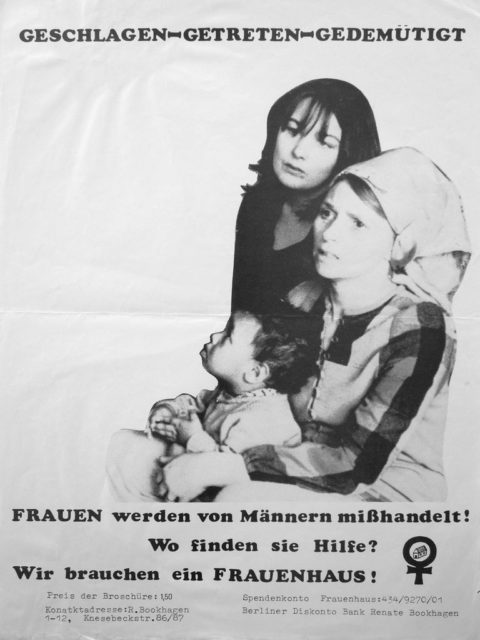
The first home for battered women opens in Berlin. The women’s refuge was initiated by the Verein zur Föderung des Schutzes misshandelter Frauen e.V. Since 1974 the feminist society comprising social workers, psychologists, doctors, and lawyers had endeavoured to finance the project. They turn to the public authorities and to ministeries for help.
A request sent to the Minister for Family Affairs Katharina Focke (SPD) remains, at first, unanswered. Only after the media gets wind of the planned project and campaigning for the general election begins on 3 October 1976 does the minister approve funding for the first German women’s project – for three years as a pilot project. The Berlin Senate contributes 20% of the costs (489,500 D-Mark)7 – but also only after public pressure mounts and a survey is carried out at marriage counselling centres in Berlin: every one in eight wives turns to counselling for help because she is being abused by her husband. When the Haus für geschlagene Frauen finally opens, the 80 places for women and children are filled within days. In the first three months alone, 193 women with 300 children seek refuge at the women’s shelter.8
1 December 1976: Women Helping Women
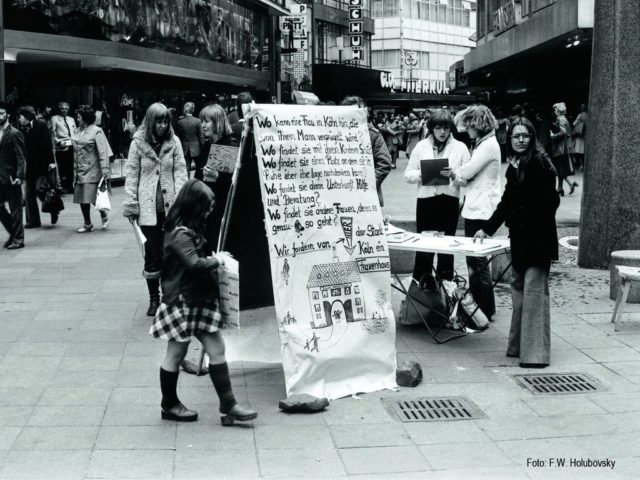
In Cologne the Verein Frauen helfen Frauen opens the second German women’s refuge. The society had emerged from a seminar at the Fachhochschule on the history of the women’s movement. A group of 15 female students who wanted to get involved in practical terms had turned to the head of social services in Cologne about establishing a women’s refuge. The department disputed the need for a women’s refuge. The students moblised the media by campaigning in pedestrian zones, collecting 2,000 signatures. After the Kölner Stadtanzeiger published the telephone number of a flat share that women could ring if they were seeking refuge, the phone rang off the hook; the initiators at first housed the women privately. The city council, which came under increasing pressure, now asked their institutions about how many women were seeking shelter from their violent husbands. The result: “They found that on average 100 women a month turned up at the police or at social institutions seeking shelter from male violence, but that these complaints could not be dealt with because violence within the family was considered a private matter”.9
Because the city remains inactive, the by now well-established society Frauen helfen Frauen rents a house itself and sets up a round-the-clock service run by volunteers. This women’s refuge is also overcrowded from day one. Finally, the city approves a position for a social worker and funding for the residents in the form of welfare. The case attracts public attention and in other cities branches of the society Frauen helfen Frauen are set up.
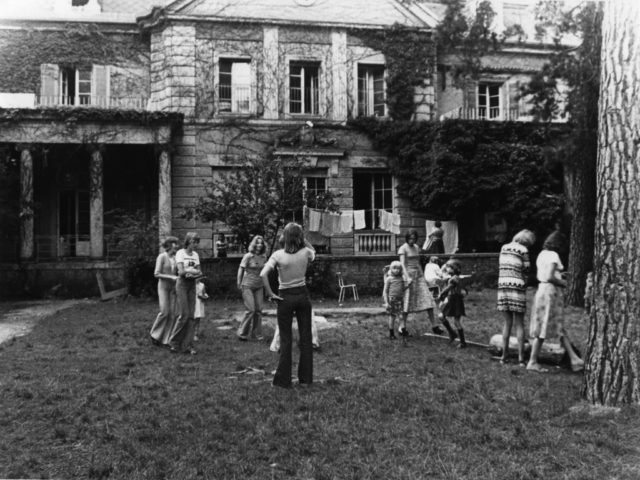
January 1977: More Refuges Founded in Germany
The women’s refuge in Bielefeld opens as the third women’s refuge in Germany. Further women’s refuges follow. On the 30th anniversary of the establishment of these first German women’s refuges, the Zentrale Informationsstelle Autonomer Frauenhäuser (ZIF) retrospectively describes the situation in 1977 as follows: “30 years ago, everday violence against women was hushed up, denied, or trivialised and declared to be an isolated case. The victims were also always apportioned the blame. Until then, there had been no place where women and children affected by violence could find support. Within the family, male violence against women could be exercised with impunity.”10
March 1977: No Statistics Available
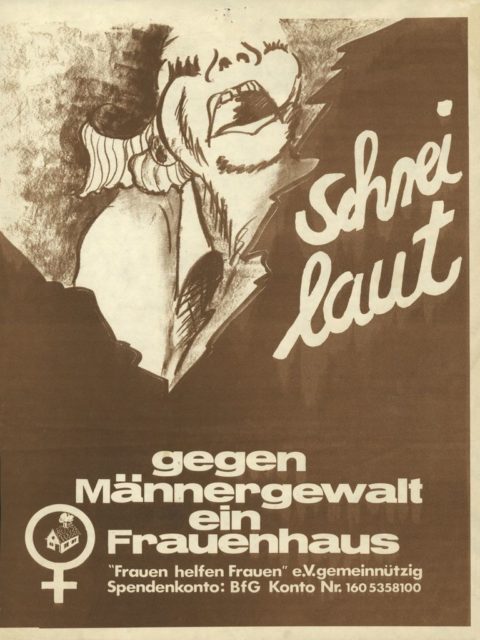
EMMA publishes the report Ein Tag im Haus für geschlagene Frauen by Alice Schwarzer. Schwarzer writes: “Estimates of the number of so-called ‘battered women’ fluctuate in Germany between 100,000 and 4 million. Surveys and statistics do not exist. This is no coincidence, but rather articulates total ignorance with respect to this problem.”11
6-8 May 1977: First National Meeting of Women’s Refuges
The first Nationales Frauenhaustreffen takes place in Cologne. Approximately 100 women from 22 initiative groups take part. The founders of the four well-established women’s refuges in Berlin, Cologne, Bielefeld, and Bremen recount their experiences, as do groups in Dortmund, Bonn, and Rendsburg who had rented apartments for women seeking protection.12
January 1978: Financing and the Problems with § 72
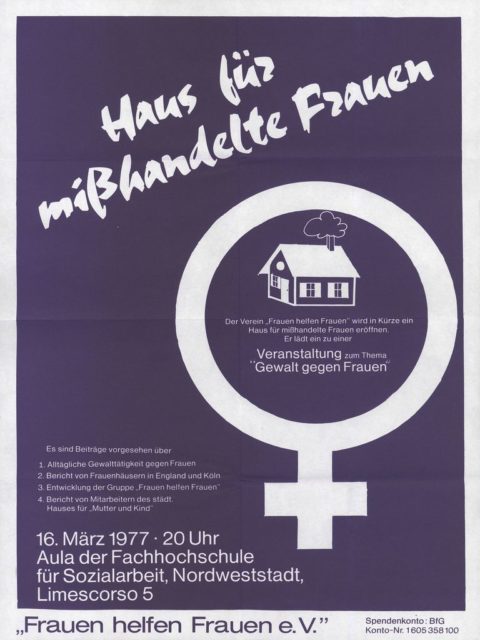
Women’s refuge initiatives fight for stable financing that does not incapacitate or stigmatise the refuges’ residents. The authorities’ plan to regulate the residency of women seeking protection in accordance with § 72 Bundessozialhilfegesetz (BSHA) is met with substantial scepticism. This is because the paragraph applies to people who “face particular social difficulties participating in community life”.13 Prerequisite for the receipt of welfare support is “that the at-risk person’s inability stems from a lack of inner strength”.14 This classification of women who have fled their abusers is a problem because their alleged ‘lack of inner strength’ can negatively impact custody proceedings. In addition: the creation of a file on every women with information about her condition violates her right to privacy, which the women’s refuge initiatives want to guarantee their residents.15 In the case of migrant women, reporting to the authorities may even lead to deportation because residency status is dependent on the continued existence of the marriage.
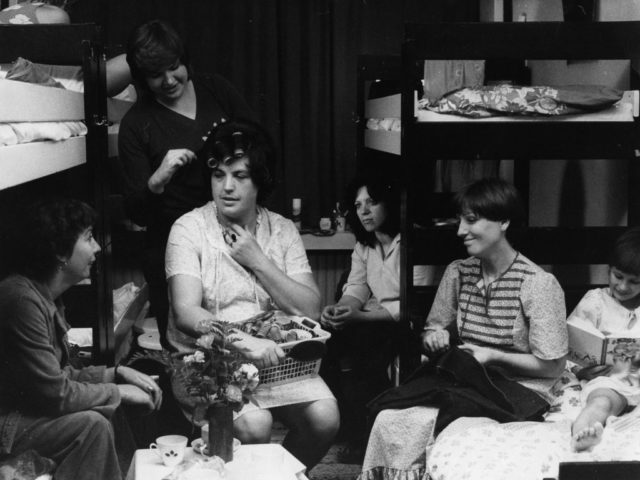
20 February 1978: Arson Attacks on Women’s Refuges
An arson attack is committed on the women’s refuge in Berlin. One year later, in January 1979, a second attack follows. Other women’s refuges are also regularly the target of attacks.
28-30 April 1978: National Tribunal – Violence Against Women
On the initiative of the Kölner Frauenzentrum, delegates from the women’s refuges organise the national tribunal Gewalt gegen Frauen. The ‘catalogue of violence’ put together by the intiators ranges from ‘violence within marriage’ and ‘fashion and beauty terror’ to ‘male-orientated language development’.
20 September 1978: Women Murdered by Their Husbands
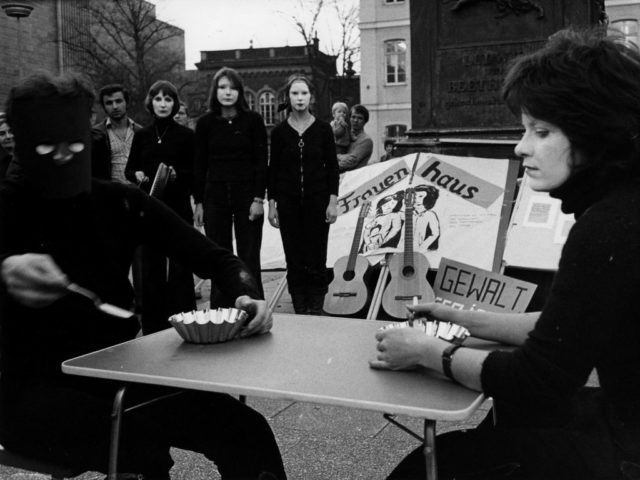
A man shoots his 23-year-old wife and then himself in front of the Munich women’s refuge. The woman had fled her abusive partner with their children and taken shelter at the refuge. The press covers the case: reporters camp out for days in front of the women’s refuge.16 Time and time again, women who had sought refuge at women’s shelters are murdered by their husbands.
7+30 November 1978: TV Movies About Marital Violence
Two TV movies broadcast by ZDF thematise marital violence and the womens’ escape to a shelter: Ehen vor Gericht (by Sina Walden) und Die Macht der Männer ist die Geduld der Frauen (by Cristina Perincioli). The programmes receive substantial media attention, and the broadcasters are sent numerous – in part violent – responses from viewers.17
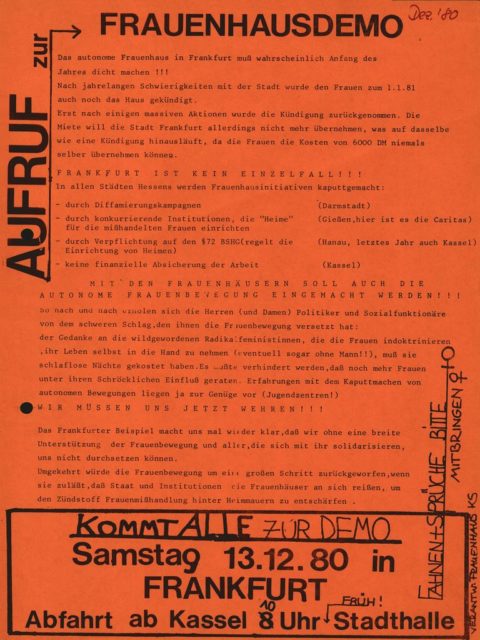
27-28 October 1979: 5th National Meeting
The 5. Nationales Frauenhaustreffen takes place in Bochum. Chief concern remains the issue of financing. The women’s refuges call for a daily flat-rate instead of financing via the Bundessozialhilfegesetz.
19 December 1979: Fighting for Financial Security
Delegations from ten of North Rhine-Westphalia’s women’s refuges demonstrate at the Landtag [federal state parliament] in Düsseldorf. They call on the Minister of Health and Welfare Friedhelm Farthmann (SPD) to provide financial security for women’s refuges.18
January 1980: Funding Challenges
After the funding for the women’s refuge pilot project in Berlin expires, the state takes over the costs; it also takes over the costs for a second women’s refuge in Berlin that opened in September 1979. The funding covers the redevelopment and initial set-up of the second women’s refuge as well as the personnel costs for six employees per refuge and 90,000 D-Mark for psychological, legal, medical, and therapeutic specialists. The refuges are financed by a block grant, rather than the Bundessozialhilfegesetz.19
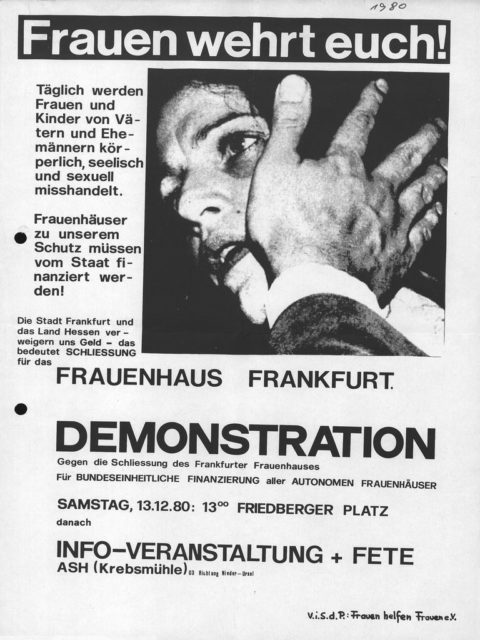
At the 8. Nationales Frauenhaustreffen in Braunschweig, the Zentrale Informationsstelle Autonomer Frauenhäuser (ZIF) is established as a networking, information, and coordination centre. There are now 30 independent women’s refuges in Germany.20
January 1981: Ruling on Financial Responsabilities
The administrative court in Düsseldorf decides: if a battered woman flees to a women’s refuge in order to “avert an acute threat to the physical and mental well-being of the spouse and/or the children”, the man can be called upon by social services to cover the costs incurred.
It is the first time that a German court concerns itself with this question. The verdict is welcomed by the women’s refuge initiatives as “a groundbreaking ruling”.21
17 April 1981: Deadly Attack in Gießen
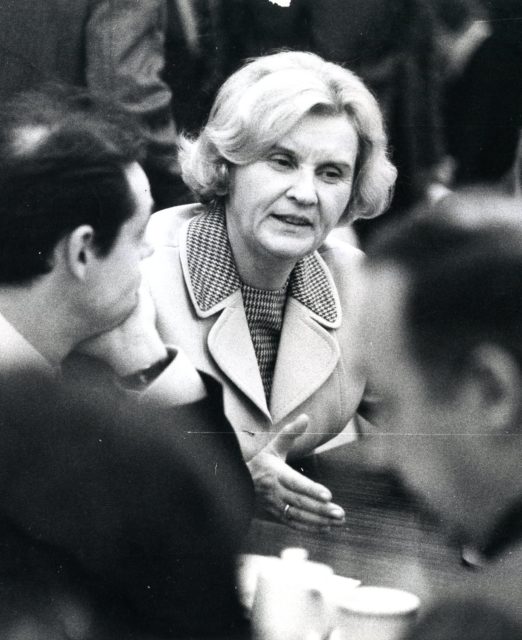
1,500 women demonstrate in Gießen against male violence after the Kurd Mehmed Urak fatally stabbed his wife Gülüzar 30 times at the women’s refuge in Gießen.22
23 March 1982: Results of Berlins Refuge Pilot Project
Minister for Family Affairs Antje Huber presents the final report of the Modellprojekt Frauenhaus Berlin that had been carried out under scientific guidance for three years. Result: between 1976 and 1979 more than 2,500 women and about as many children sought refuge at the women’s shelter. The demand – so vehemently denied before the opening of the first women’s refuge – is now officially beyond doubt: “The abuse of women and violence within the family, also against children, has long been a taboo subject. The foundation of women’s refuges has helped to publicise the problem of violence against women and to initiate a shift in attitudes.”23
![1 Jahr Frauenhaus Heidelberg - und nun? Frauen Helfen Frauen <Heidelberg> [Hrsg.]. Heidelberg: Selbstverlag, 1981, S. 6 (FMT-Signatur: SE.07.085) 1 Jahr Frauenhaus Heidelberg - und nun? Frauen Helfen Frauen [Hrsg.]. Heidelberg: Selbstverlag, 1981, S. 6 (FMT-shelfmark: SE.07.085)](http://frauenmediaturm.de/wp-content/uploads/2018/07/Das_Leben_im_Frauenhaus-640x430.jpg)
1983: First Women’s Refuge Report
The government presents the Erster Frauenhausbericht. It determines: “There are now well over 100 women’s refuges in Germany, mostly in large and medium-sized cities and still very rarely in rural areas. The responsible bodies are often initiative groups from the autonomous women’s movement, free welfare associations and comparable institutions. Therefore, a distinction is made in practice between independent and non-independent women’s refuges.”
![1 Jahr Frauenhaus Heidelberg - und nun? Frauen Helfen Frauen <Heidelberg> [Hrsg.]. Heidelberg: Selbstverlag, 1981, (FMT-Signatur: SE.07.085) 1 Jahr Frauenhaus Heidelberg - und nun? Frauen Helfen Frauen [Hrsg.]. Heidelberg: Selbstverlag, 1981, (FMT-shelfmark: SE.07.085)](http://frauenmediaturm.de/wp-content/uploads/2018/07/Frauenhaus_2-640x587.jpg)
The key focus of the report is the question of how to finance the women’s refuges. Because: “Without new legal protections, the bodies responsible for women’s refuges (…) consider their existence to be threatened.”
The financing of women’s refuges is at the discretion of the state or local authority which is why women’s refuges demand block grants based on average occupancy. This should be legally regulated nationwide in a consistent fashion. However, the federal government declares: “In the goverment’s view, grounds for the creation of new federal legislation to secure the funding of women’s refuges are lacking. The current regulations are considered to be sufficient.”
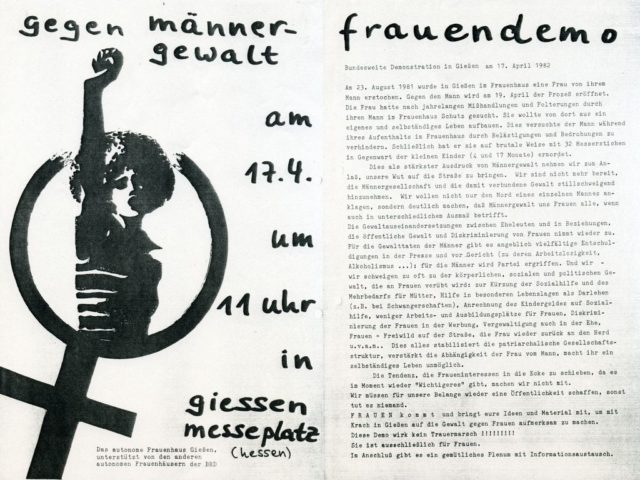
12-13 January 1984: Symposium in Bonn
The Ministry for Family Affairs organises the symposium Gewalt gegen Frauen in Bonn. Social workers, lawyers, doctors, police officers, journalists, women from (independent) women’s refuges, and representatives from emergency hotlines for victims of rape discuss the manifestations and the causes of violence against women as well as the options for getting help.
September 1988: Official Figures on Women’s Refuges
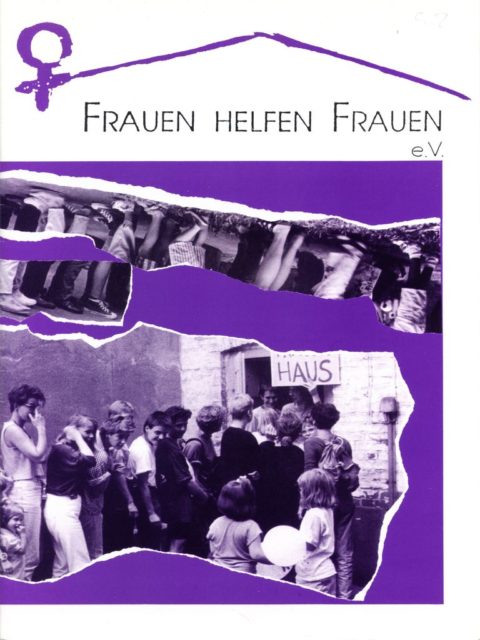
The government submits the Zweiter Bericht über die Lage der Frauenhäuser. For the first time, official figures are available on the use of women’s refuges: an estimated 25,000 abused women and about the same number of children seek refuge each year at the approximately 180 women’s refuges, of which about 100 are independent. 10% to 30% are migrants.
What Happens Next?
The first women’s refuges are created in East Germany after reunification. There were no women’s refuges in the GDR because according to the official version of events male violence within marriage and the family did not exist. In contrast to the West, there had not been a strong women’s movement to shine light on domestic violence and to establish women’s refuges and counselling centres. Women at the East German refuges, however, report comparable violence by men against women during the GDR.25
![Leitfaden für Frauen in Frauenhäusern. Frauenhausgruppe <Frankfurt> [Hrsg.]. - Frankfurt a.M.: Selbstverlag, 1985. (FMT-Signatur: SE.07.034) Leitfaden für Frauen in Frauenhäusern. Frauenhausgruppe [Hrsg.]. - Frankfurt a.M.: Selbstverlag, 1985. (FMT-shelfmark: SE.07.034)](http://frauenmediaturm.de/wp-content/uploads/2018/07/Leitfaden_fuer_Frauen_in_Frauenhaeusern-480x640.jpg)
A further paradigm shift: the police are required to remove the abuser from the property and file a criminal charge, even without the victim’s cooperation. Police officers have now received training – also by staff from women’s refuges – on the mechanisms of abuse within relationships and know about the victim’s (financial and psychological) dependence on their abuser. The Gewaltschutzgesetz – which was modelled on Austria’s “Gesetz zum Schutz vor Gewalt in der Familie” – was promoted by the Minister for Women Christine Bergmann and the Minister of Justice Hertha Däubler-Gmelin (SPD).
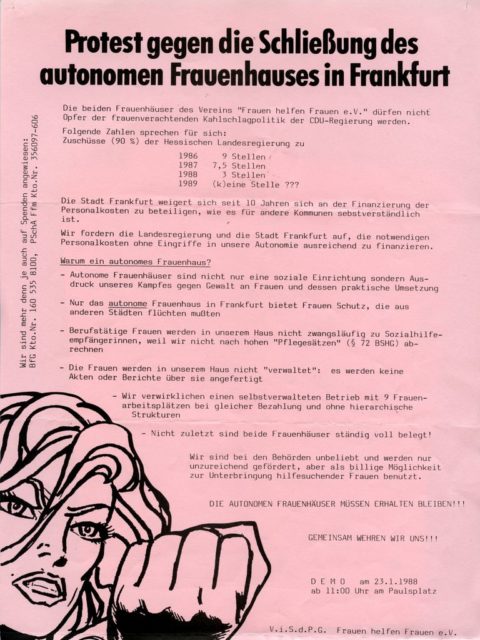
The Ministry for Women’s Affairs publishes the study Lebenssituation, Sicherheit und Gesundheit von Frauen in Deutschland in December 2004. With 10,000 respondents, it is the largest study about violence against women ever conducted in Germany. Result: “Around 25% of women between the ages of 16 and 85 have experienced physical and/or sexual violence at the hands of their partners.” And further: “Two-thirds of women affected by domestic violence have suffered severe or very severe physical and/or sexual violence. Women are therefore more likely to be the victims of domestic violence than the victims of other violent crimes such as assault with a (deadly) weapon, domestic burglary, or theft. The risk factors for abuse include – in addition to the break-up of a relationship or the intention to break-up – the experience of violence as a child and adolescent. Women are by no means only beaten, raped, insulted, or humiliated by their partners in anti-social areas.” Women “with middle-to-upper class backgrounds” are also “victims of violence to a much larger extent than was previously known”. According to the study, migrants are disproportionately affected by relationship violence. About every second resident in a women’s refuge has a migrant background.
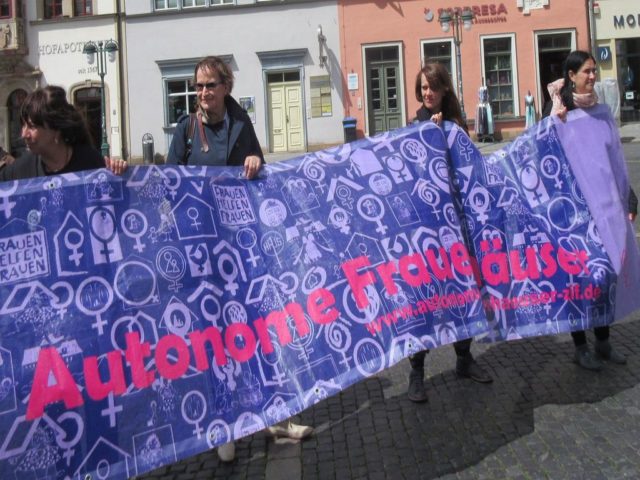
From 2011 the Bundeskriminalamte [Federal Criminal Police] records relationship violence in its crime statistics and thus fulfils a decades-old demand by the women’s movement. The helpline Gewalt gegen Frauen set up in March 2013 at the Bundesamt für Familie und zivilgesellschaftliche Aufgaben (BAFzA) registers 47,504 calls in its first year.26 In 2014, 73,830 women file a complaint for assault by an (ex-)husband or (ex-)partner. 241 women were killed by their (ex-)husbands.
There are currently around 350 women’s refuges in Germany, of which approximately 130 are independently run. Since the turn of the millennium, around 80 women’s refuges have been forced to close due to lack of money after federal states and local authorities cut funding. With the exception of Schleswig-Holstein, the funding for women’s refuges is still neither a state nor a local authority obligation, and a federal law for the financing of women’s refuges still does not exist.

Germany does not meet the Council of Europe’s recommended quota of one women’s refuge spot per 7,500 residents. The Zentrale Informationsstelle Autonomer Frauenhäuser (ZIF) has determined: “As a result, the number of women in Germany who have to be turned away, or rather referred, due to overcrowding far exceeds the number of women admitted to women’s refuges in Germany.”27
References
1Pizzey, Erin (1984): Schrei leise : Mißhandlungen in der Familie. - Frankfurt am Main : Fischer-Taschenbuch-Verl. (FMT Shelf Mark SE.07.008). Original from 1971; German first edition from 1974.
2See Falsche Scham (1976). - In: Der Spiegel, 08.11.1976, see Pressedokumentation: Frauenhäuser A-H (FMT Shelf Mark: PD-FE.07.04, Kapitel 4).
3Glahn, Lisa (1998): Frauen im Aufbruch : 20 Jahre Geschichte und Gegenwart Autonomer Frauenhäuser. München : Unrast-Verl., p. 22 f.
4Simone de Beauvoir schickte dem Tribunal folgende Grußbotschaft (1976). - In: AUF, Nr. 7, verso of cover page. See Grußwort in the French original by Simone de Beauvoir in Chronik der Neuen Frauenbewegung 1976 (FMT Shelf Mark PD-FE.03.01).
5Schippke, Ulrich (1976): Mein Mann hat mich vergewaltigt. - In: Der Spiegel, Nr. 17, pp. 68-74, see Pressedokumentation: Gewalt in der Ehe II 1976-1992 (FMT Shelf Mark PD-SE.03.09).
6Sarah Haffner (1976): Gewalt in der Ehe und was Frauen dagegen tun : Frauenhäuser. - Berlin : Wagenbach (FMT Shelf Mark SE.07.09).
7Informationen des Bundesministeriums für Jugend, Familie und Gesundheit (1976): Modellversuch „Hilfen für misshandelte Frauen“ wird vom Bundesminsterium für Jugend, Familie und Gesundheit gefördert, 30.09.1976, see Pressedokumentation: Frauenhäuser A-H (FMT Shelf Mark PD-SE.07.04, Kapitel 4).
8Verein zur Förderung des Schutzes mißhandelter Frauen (1976): [Brief an die Senatsverwaltung für Bildung, Jugend und Familie], 09.12.1976, see Pressedokumentation: Frauenhäuser A-H (FMT Shelf Mark PD-SE.07.04, chapter 4).
9Maria Mies: Der Kampf um das Frauenhaus Köln. - Retrieved from: Zentrale Informationsstelle Autonomer Frauenhäuser ZIF: http://www.autonome-frauenhaeuser-zif.de/sites/default/files/page_attachment/Kampf%20um%20das%20FH%20K%C3%B6ln%20M.Mies_.pdf [PDF Document].
10Zentrale Informationsstelle Autonomer Frauenhäuser ZIF (2006): Pressemitteilung 30 Jahre Frauenhäuser 1976-2006, 15.11.2006. - Retrieved from: Zentrale Informationsstelle Autonomer Frauenhäuser ZIF: http://www.autonome-frauenhaeuser-zif.de/sites/default/files/page_attachment/pressemitteilung_30_jahre_1.pdf [PDF Document].
11Schwarzer, Alice (1977): Ein Tag im Haus für geschlagene Frauen. - In: EMMA, no. 2, pp. 6-12.
12Frauen helfen Frauen e.V. (1977): Nationales Frauenhaustreffen in Köln : Protokolle 15/1977, see Pressedokumentation: Frauenhäuser II (FMT Shelf Mark PD-SE.07.03, chapter 6).
13Neuer Angriff auf selbstverwaltete Frauenhäuser. (1979) - In: Arbeiterkampf, 08.01.1979, see Pressedokumentation: Frauenhäuser I (FMT Shelf Mark PD-SE.07.02).
14Roggenkamp, Viola (1980): Als haltlos abgestempelt : Mit Hilfe eines fragwürdigen Paragraphen werden Frauenhäuser kaputtgemacht. - In: Die Zeit, 07.04.1980, see Pressedokumentation: Frauenhäuser II, siehe Pressedokumentation: Frauenhäuser II (FMT Shelf Mark PD-SE.07.03, Kapitel 9).
15Gefahr für Frauenhäuser? : Paragraph 72 des Sozialhilfegesetzes stößt auf Ablehnung (1978). - In: Frankfurter Rundschau, 07.11.1978, see Pressedokumentation: Frauenhäuser II (FMT Shelf Mark PD-SE.07.039).
16Mord im Frauenhaus? (1978) - In: EMMA, no. 11., p. 43.
17See Flut unflätiger Anrufe bei Frauenhäusern nach TV-Film (1978). - In: Frankfurter Rundschau, 09.11.1978 / Die Macht der Männer ist die Geduld der Frauen (1978). - In: die tageszeitung, 02.12.1978 / Koch, Getrud (1979): Die tägliche Gewalt : C. Perinciolis Spielfilm über Gewalt gegen Frauen - In: Frankfurter Rundschau, 08.05.1979. For all three articles (und others), see Pressedokumentation: Frauenhäuser I (FMT Shelf Mark PD-SE.07.02).
18Frauen demonstrierten im Landtag (1979). - In: Frankfurter Rundschau, 20.12.1979, see Pressedokumentation: Frauenhäuser K-W (FMT Shelf Mark PD-SE.07.05, chapter 23) / Mißhandelte Frauen auf der Suche nach dem Minister (1979). - In: Kölnische Rundschau, 20.12.1979, see Pressedokumentation: Frauenhäuser II (FMT Shelf Mark PD-SE.07.03, chapter 3).
19In drei Jahren fanden 2180 Frauen eine Zuflucht im Frauenhaus (1979). - In: Tagesspiegel 07.11.1979, see Pressedokumentation: Frauenhäuser A-H (FMT Shelf Mark PD-SE.07.04).
20Gewagtes Stück (1981). - In: Der Spiegel, 02.02.1981, see Pressedokumentation: Frauenhäuser II (FMT Shelf Mark PD-SE.07.03, chapter 8).
21Ibid.
22Gekränkte Ehre : Prozeß in Gießen (1982). - In: die tageszeitung, 22.04.1982 / Prozeß wegen Mordes im Frauenhaus : Große Öffentlichkeit in Gießen (1982). - In: die tageszeitung, 22.04.1982 / Frauendemo gegen Männergewalt [Leaflet: Aufruf zur Frauendemo am 17.04.1982]. See Pressedokumentation: Frauenmord I: Mord an Ehefrauen und Lebensgefährtinnen (FMT Shelf Mark PD-SE.01.02).
23Problem der Gewalt in der Familie wird verharmlost (1982). - In: die tageszeitung, 24.03.1984, see Pressedokumentation: Frauenhäuser II (FMT Shelf Mark PD-SE.07.03, chapter 3).
24Deutscher Bundestag, 10. Wahlperiode (1983): Bericht der Bundesregierung zur Frage, ob bundesgesetzliche Grundlagen zur Finanzierung von Frauenhäusern geschaffen werden können, Drucksache 10/291 vom 08.08.1983, see Pressedokumentation: Frauenhäuser II (FMT Shelf Mark PD-SE.07.03, Kapitel 3).
25Louis, Chantal (2010): Ein Blick ins Frauenhaus. - In. EMMA, no. 1, pp. 124-129.
26 EMMA News vom 1. 04.2014: 47.504 Anrufe beim Hilfetelefon https://www.emma.de/artikel/gewalt-47504-anrufe-beim-hilfetelefon-316729
27 Risse, Eva (2014): Stellungnahme zum nichtöffentlichen Fachgespräch zur Situation der Frauenhäuser am 10. November 2014, 31.10. - Retrieved from: Zentrale Informationsstelle Autonomer Frauenhäuser ZIF: http://www.autonome-frauenhaeuser-zif.de/sites/default/files/report_attachment/zif-stellungnahme_zum_fachgespraech_zur_situation_der_frauenhaeuser_10.11.2014.pdf [PDF Document].
All internet links were last accessed on 5.09.2018.
Selective Bibliography
Documents online
Leonhardt, Rudolf Walter (1976): Die Frauen als Opfer der Männer. - In: Die Zeit, 27.02.1976.
Schwarzer, Alice (1977): Ein Tag im Haus für geschlagene Frauen. - In: EMMA, no. 2, pp. 6-12.
Recommendations
Frauen gegen Männergewalt : Berliner Frauenhaus für mißhandelte Frauen ; erster Erfahrungsbericht (1978). - Berliner Frauenhaus für Misshandelte Frauen [Hrsg.]. Berlin : FrauenSelbstverl. (FMT Shelf Mark SE.07.016).
Gewalt in der Ehe und was Frauen dagegen tun : Frauenhäuser. - Haffner, Sarah [ed.]. Berlin : Wagenbach, 1976. (FMT Shelf Mark SE.07.009).
Hilfen für mißhandelte Frauen : Abschlußbericht der wissenschaftlichen Begleitung des Modellprojekts Frauenhaus Berlin (1981). - Bundesministerium für Jugend, Familie und Gesundheit [ed.]. Stuttgart [i.a.] : Kohlhammer. (Schriftenreihe / Bundesminister für Jugend, Familie und Gesundheit, 124). (FMT Shelf Mark SE.07.007).
Pizzey, Erin (1984): Schrei leise : Mißhandlungen in der Familie. - Frankfurt am Main : Fischer-Taschenbuch-Verl. (FMT Shelf Mark SE.07.008).
FMT Press Documentation
Press Documentation on Women's Refuges: PDF-Download
The FMT press documentation is thematically structured and indexed. It comprises articles of the general public press, feminist press and other documents, such as leaflets and archival documents.
Selected FMT-Sources (lists)
FMT literature selection Women's Refuges: PDF-Download
EMMA article Women's Refuges: PDF-Download
Related Topics
Fighting Sexual Violence and (Marital) Rape
Fighting Sexual Violence and (Marital) Rape
In the mid-1970s, the women’s movement brought the epidemic of sexual violence to the public’s attention. The women fought for a sex crime law reform, that finally came through 1997 and 2016. In Germany today the principle rules: No means No. › mehr
Sexual Abuse - When Crime Begins Within the Family
Sexual Abuse - When Crime Begins Within the Family
In 1978 feminist magazine EMMA first broke the silence of a long-held taboo: sexual abuse. 5 years later the self-help group Wildwasser and the first girls’ refuge were established. › mehr
Sexual Harassment - the Long Way to Sex Crime Legislation
Sexual Harassment - the Long Way to Sex Crime Legislation
Sexual harassment in the workplace became a public issue in Germany in the late 1970s, studies and debates have followed until it finally became a part of the sex crime legislation. › mehr


